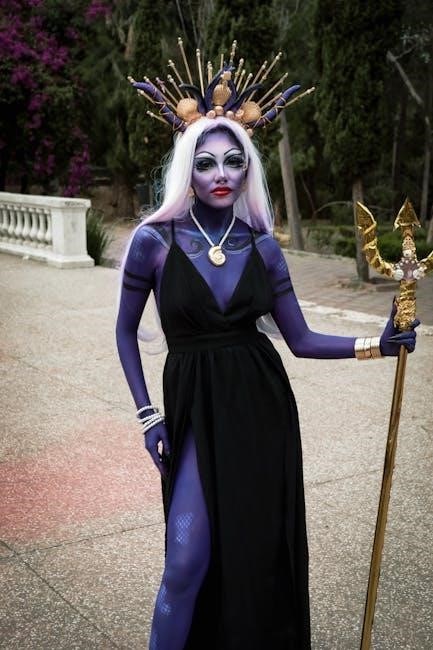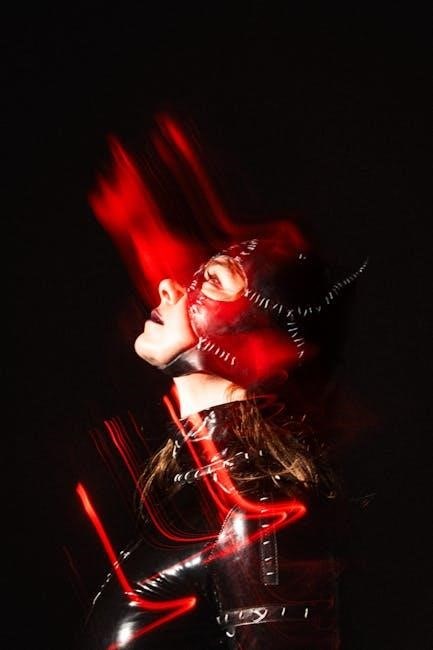John Proctor is the Villain reimagines the classic tale with a modern twist, exploring Proctor’s moral flaws and the consequences of his actions in a contemporary setting.
1.1 Background of the Play
John Proctor is the Villain is a modern retelling of Arthur Miller’s The Crucible, reimagined in a contemporary Southern high school setting. The play, written by Kimberly Belflower, explores themes of morality, guilt, and societal judgment through the lens of teenage drama. Drawing inspiration from Miller’s exploration of McCarthyism, Belflower situates the story in a small Georgia town, where rigid social norms and gender roles dominate. The narrative centers on a group of high school students studying The Crucible, whose discussions about John Proctor’s character spark a deeper examination of his moral flaws. By blending pop music, humor, and biting commentary, the play offers a fresh perspective on Proctor’s legacy, challenging audiences to reconsider their perceptions of heroism and villainy.
1.2 The Playwright’s Vision
Kimberly Belflower’s vision for John Proctor is the Villain is a bold reinterpretation of Arthur Miller’s classic, challenging audiences to question their assumptions about morality and villainy. By setting the play in a contemporary Southern high school, Belflower creates a relatable and intimate world where teenage struggles mirror the witch-hunt hysteria of Miller’s original. Her vision emphasizes the complexities of human behavior, particularly through John Proctor’s character, whose flaws and mistakes are amplified in a modern context. The playwright uses humor, pop music, and sharp dialogue to make the story resonate with younger audiences while maintaining the emotional depth of the original. This fresh perspective invites viewers to reflect on how societal expectations and personal choices shape our understanding of right and wrong.

The Modern Retelling of “The Crucible”
John Proctor is the Villain reimagines the classic tale in a contemporary high school setting, where teenagers grapple with the original themes through pop music and humor, offering a fresh perspective.
2.1 Setting: From Salem to the Modern South
John Proctor is the Villain shifts the iconic Salem setting of The Crucible to a contemporary Southern high school, blending the original’s tense atmosphere with modern teen culture. The play situates its story in a small, one-stoplight town in Georgia, where rigid social norms and gender roles resemble the oppressive climate of 17th-century Massachusetts. By reimagining the setting, the play highlights how the themes of reputation, power, and hysteria remain timeless. The high school environment, complete with classrooms and pop music, adds a fresh layer of relatability, allowing audiences to connect the historical drama to today’s societal challenges. This modern retelling not only refreshes the classic narrative but also underscores its enduring relevance in contemporary society.
2.2 The Role of Social Norms in the Play
John Proctor is the Villain explores the oppressive power of social norms, both in the historical Salem setting and its modern Southern reinterpretation. The play highlights how rigid expectations around gender roles, reputation, and morality can control individuals’ lives. In the contemporary high school setting, these norms manifest as pressures on teenagers to conform to societal standards, particularly regarding sexuality and reputation. The play critiques how fear of judgment and the desire to fit in can lead to hysteria and false accusations, mirroring the witch trials of The Crucible. By examining these dynamics, the play underscores the enduring impact of societal expectations on personal freedom and truth. This theme resonates deeply, showing how little some aspects of human behavior have changed over time.

Character Analysis: John Proctor as the Villain
John Proctor, once seen as a tragic hero, is reimagined as a flawed figure whose affair and pride drive the play’s conflict, revealing his moral failings and ultimate downfall.
3.1 John Proctor’s Moral Complexity
John Proctor is portrayed as a deeply flawed yet multidimensional character, whose moral ambiguity is central to the play’s narrative. His initial honesty and integrity are overshadowed by his secret affair with Abigail Williams, which underscores his vulnerability totemptation. This moral failing not only fuels Abigail’s jealousy but also sets the stage for the witch hysteria that engulfs the community. In the modern retelling, Proctor’s character is analyzed through the lens of high school students, who question his actions and motivations, further highlighting his complexity. His struggle to reconcile his past mistakes with his desire for redemption adds layers to his character, making him both relatable and culpable. This duality challenges the audience to grapple with the nature of morality and accountability.
3.2 The Affair with Abigail Williams

John Proctor’s affair with Abigail Williams is a pivotal element in the play, serving as the catalyst for the unfolding drama. Their relationship, which occurs before the main events of the story, creates a web of jealousy and resentment, particularly toward Proctor’s wife, Elizabeth. Abigail’s obsession with Proctor and her refusal to accept the end of their affair drive her to falsely accuse Elizabeth of witchcraft, setting the stage for the witch hysteria. In the modern retelling, this affair is reexamined through the lens of contemporary social dynamics, highlighting themes of power, consent, and the consequences of unchecked desire. The affair not only underscores Proctor’s moral failings but also illustrates the destructive nature of unrequited love and manipulation.
3.4 The Transformation of John Proctor’s Image
John Proctor’s image undergoes a significant transformation as the play challenges the traditional portrayal of him as a tragic hero. Initially seen as an upright, honest man, Proctor’s flaws are exposed through his affair with Abigail and his inability to confront his mistakes. The modern retelling amplifies his moral ambiguity, painting him as a complex, multidimensional figure whose actions have far-reaching consequences. By shifting the narrative to a contemporary setting, the play recontextualizes Proctor’s character, emphasizing his role as a catalyst for the chaos that ensues. This transformation forces audiences to question their preconceived notions of heroism and villainy, ultimately presenting a more nuanced exploration of human nature and accountability.

The Play’s Themes
The play explores themes of justice, truth, and power dynamics, resonating with the MeToo movement, while challenging perceptions of human nature and accountability.
4.1 The MeToo Movement and Its Influence
The play John Proctor is the Villain draws parallels to the MeToo movement, exploring themes of power imbalance, accountability, and the complexities of victimhood. Debuting in 2018, it coincided with heightened discussions about sexual misconduct and systemic oppression. By reframing John Proctor’s character as the villain, the play challenges traditional narratives, emphasizing the consequences of his actions and the lasting impact on Abigail Williams. This perspective aligns with MeToo’s focus on amplifying marginalized voices and questioning structures that enable abuse. The play’s modern setting, particularly in a high school context, allows it to resonate with younger audiences, using dark humor and pop music to address these heavy themes. Ultimately, it sparks a conversation about consent, justice, and the societal norms that perpetuate inequality.
4.2 McCarthyism and Modern Parallels
Arthur Miller’s The Crucible, the inspiration for John Proctor is the Villain, was originally a critique of McCarthyism, a period of political hysteria and fear-mongering in 1950s America. Similarly, Kimberly Belflower’s play draws parallels to modern societal issues, such as mass fear, misinformation, and the dangers of unchecked power. By reimagining the story in a contemporary high school setting, the play highlights how the dynamics of fear, accusations, and groupthink remain timeless. The modern retelling reflects on how McCarthyism’s legacy continues to resonate, urging audiences to reflect on the consequences of mass hysteria and the erosion of civil liberties. This adaptation serves as a cautionary tale, bridging historical and contemporary concerns about justice, truth, and societal manipulation.
4.3 The Struggle for Justice and Truth

The play John Proctor is the Villain delves into the universal struggle for justice and truth, echoing Arthur Miller’s original themes in The Crucible. Proctor’s journey reflects the moral dilemmas of standing up against false accusations and societal hysteria. In the modern adaptation, this struggle is reimagined through the lens of contemporary issues, such as high school politics and social media influen

Plot Elements
The play incorporates a high school setting, teenage dynamics, and pop music, blending humor with serious themes to refresh the classic tale for modern audiences.
5.1 The High School Setting and Its Significance
John Proctor is the Villain is set in a contemporary high school in a small Southern town, mirroring the oppressive atmosphere of Salem. The high school environment serves as a microcosm for societal pressures, where reputation, social norms, and adolescent struggles amplify the tension. By situating the story in a modern educational setting, the play bridges the gap between the historical witch trials and current issues, making the themes relatable to younger audiences. The high school setting also allows for the exploration of teenage dynamics, peer influence, and the challenges of navigating identity, all of which are central to the play’s narrative. This modern retelling underscores how the dangers of fear, misinformation, and mob mentality remain timeless.

5.2 The Role of Teenagers in the Story
John Proctor is the Villain centers on five high school girls navigating their identities and societal expectations. These teenagers serve as the emotional core of the play, using their discussions of The Crucible to explore personal struggles and friendships. Their interactions reveal the challenges of adolescence, such as peer pressure, self-discovery, and the complexities of morality. The play leverages their perspectives to examine how historical themes like guilt, shame, and accusations resonate in modern life. Through their voices, the story critiques toxic social dynamics and the dangers of unchecked power, making the teenagers both relatable and integral to the narrative’s progression. Their journey mirrors the broader themes of justice, truth, and redemption, highlighting the enduring relevance of Miller’s original work.
5.3 The Use of Pop Music and Humor
John Proctor is the Villain uniquely blends pop music and humor to create a dynamic narrative. The play’s soundtrack, featuring contemporary pop tracks, adds a modern vibrancy, contrasting the dark undertones of the story. Humor is used strategically to highlight the absurdity of societal norms and the hypocrisy of characters. These elements make the play relatable to a younger audience while maintaining its emotional depth. The fusion of music and comedy allows the playwright to explore complex themes like guilt, morality, and redemption in an engaging way. This approach not only entertains but also provokes reflection, making the story resonate with contemporary audiences. The use of pop culture and humor underscores the play’s relevance in addressing timeless issues through a fresh lens.

Critical Reception and Broadway Success
John Proctor is the Villain has garnered significant acclaim, earning seven Tony Award nominations. Sadie Sink’s standout debut and the play’s bold narrative have captivated audiences and critics alike, securing its Broadway success and extending its run through July 13, 2025.
6.1 Tony Award Nominations and Acclaim
John Proctor is the Villain has received widespread recognition with seven Tony Award nominations, including Best Play and acting nods. Sadie Sink’s Broadway debut has been praised, and the production’s bold approach to reimagining The Crucible has resonated with audiences. The play’s extension through July 13, 2025, highlights its commercial success. Critics acclaim its blend of humor and biting commentary on modern issues like McCarthyism and the MeToo movement. The Tony nominations underscore its artistic merit and cultural relevance, solidifying its place as a significant work in contemporary theater. This acclaim not only reflects its impact on Broadway but also its potential to influence future productions and conversations in American drama.

6.2 The Impact of Sadie Sink’s Debut
Sadie Sink’s Broadway debut in John Proctor is the Villain has garnered significant attention, bringing fresh energy to the production. Her portrayal of a complex character has been praised for its depth and nuance, captivating both critics and audiences. Sink’s performance has been highlighted as a standout element, drawing younger viewers to the theater. Her involvement has not only elevated the play’s profile but also showcased her versatility as an actress. The debut has been celebrated as a bold step in her career, further cementing the play’s relevance among contemporary audiences. Sink’s presence has undeniably contributed to the production’s success and appeal, making her a memorable addition to the Broadway scene.
6.3 Audience and Critical Reviews
John Proctor is the Villain has received a mixed yet impactful response from both audiences and critics. The play’s bold reinterpretation of The Crucible has sparked lively debates, with many praising its fresh perspective and contemporary relevance. Critics have highlighted the production’s ability to blend biting humor with deep emotional resonance, making it a standout on Broadway. Audience reactions have been equally divided, with some applauding its audacity and others finding it controversial. The play’s ability to provoke thought and challenge traditional narratives has been widely acknowledged; With its dynamic performances and innovative storytelling, John Proctor is the Villain continues to leave a lasting impression on its viewers, solidifying its place as a provocative and memorable theatrical experience.
John Proctor is the Villain leaves a lasting impact, challenging traditional narratives and provoking thought on morality, justice, and societal norms, remaining deeply relevant today.
7.1 The Play’s Relevance in Contemporary Society
John Proctor is the Villain resonates deeply in today’s society, tackling themes like toxic masculinity, sexual misconduct, and the weaponization of accusations. By modernizing The Crucible, the play highlights how historical injustices mirror contemporary issues, such as the MeToo movement and cancel culture. Its high school setting and teenage characters make it relatable to younger audiences, while its humor and pop music infusions bridge generational gaps. The play’s exploration of moral ambiguity and societal judgment challenges viewers to reflect on their own roles in perpetuating or combating injustice. Its Broadway success and Tony nominations underscore its relevance, proving that classic stories, when reimagined, can speak powerfully to modern concerns. This adaptation ensures that Miller’s legacy continues to provoke thought in a new era.
7.2 The Future of American Theater
John Proctor is the Villain signifies a bold step in the evolution of American theater, blending classic themes with modern storytelling. Its innovative approach, combining humor, pop music, and contemporary settings, attracts younger audiences while maintaining the depth of Arthur Miller’s original work. The play’s success, including Tony nominations, highlights the growing appetite for reimagined classics that resonate with today’s societal challenges. By centering teenage voices and exploring complex moral dilemmas, it reflects the diversity and urgency of modern storytelling. This production, alongside others like it, suggests a vibrant future for American theater, where tradition meets innovation. Its impact underscores the importance of fresh perspectives in keeping the art form dynamic and relevant for future generations.